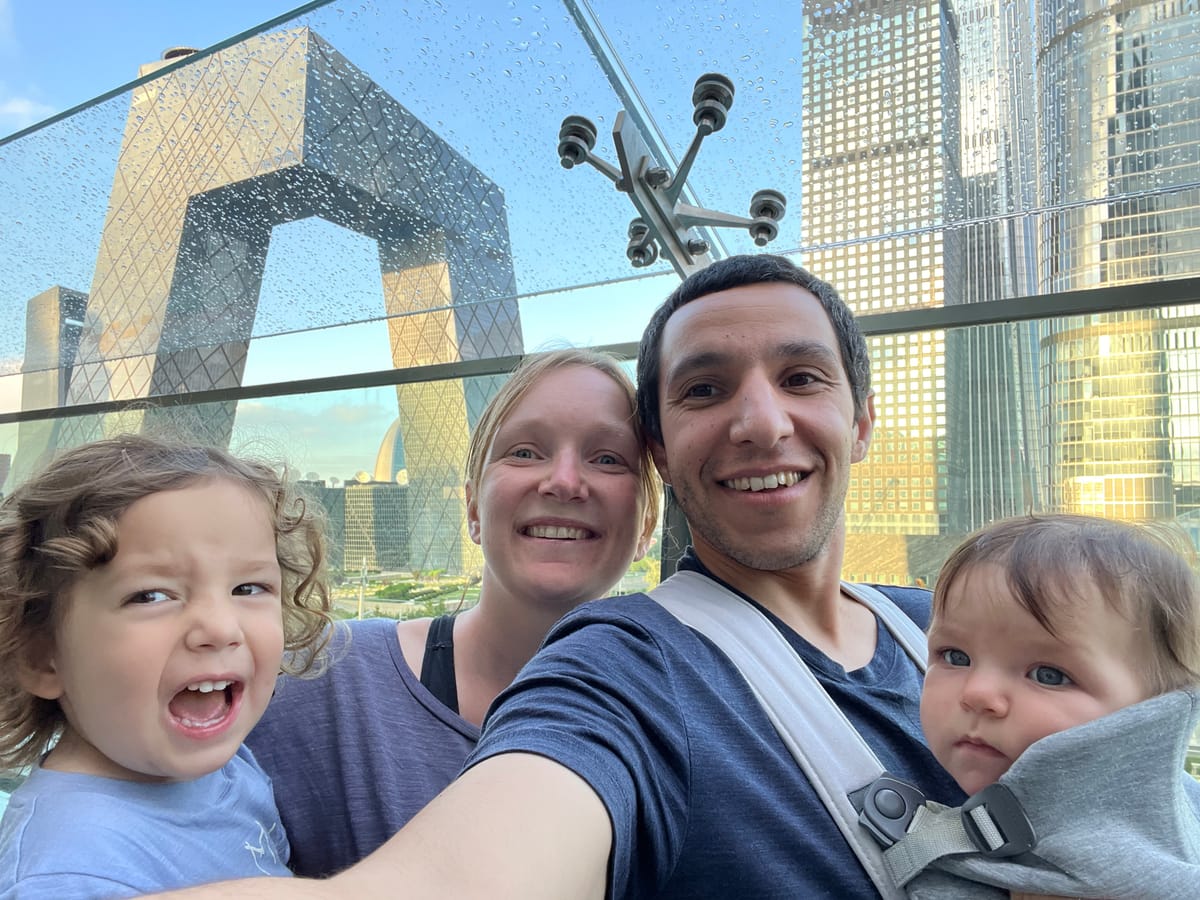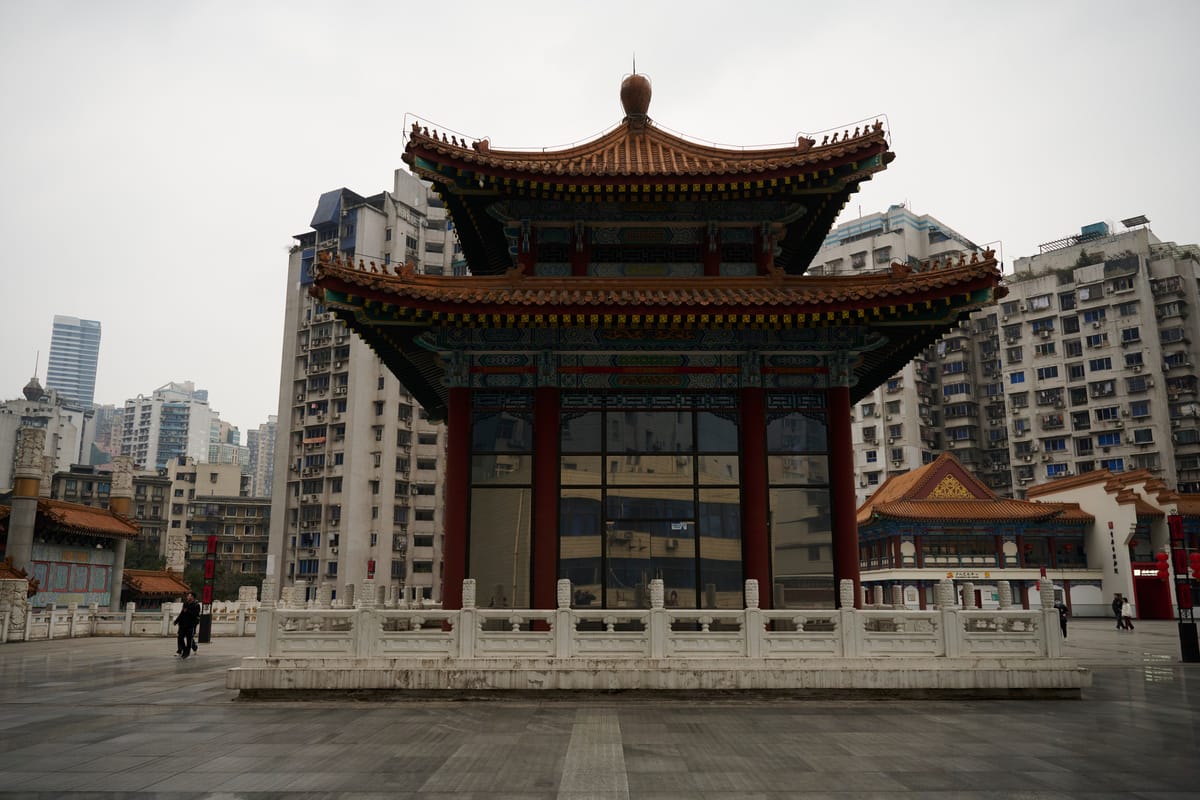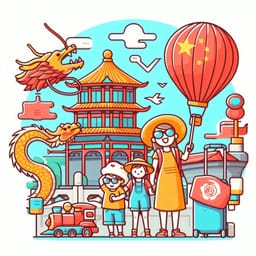Trip Overview
🛤️ Transport: Train-based journey
⏱️ Duration: 3 weeks
💲 Budget: $1200-$1700 total
🌡️ Best Time: Year-round
🏃♂️ Pace: Moderate
🗺️ Route: Beijing → Zhaoxing → Chongqing → Lanzhou → Xi'an
🚂 Total Travel Time: 29 hours
Ready to Plan Your Big China Adventure?
✈️ Book your flights
🏨 Find hotels
🚂 Reserve train tickets
🎫 Book activities
🚌 Book a tour
Is This Route Right for You?
✅ Perfect for travellers who:
- travel independently, doing their own thing
- like train travel
❌ Consider a different route if you:
- are short on time
- prefer to stick to one region to avoid extensive traveling
Sound like you need a different plan? Check out my other itineraries:



Preparing for Your China Trip
China Travel Requirements
Most nationalities need a visa to travel to China even for short stays. Make sure to research beforehand whether you qualify for an exemption.

You should apply for your visa 1-2 months in advance in a Chinese visa centre. Do it as soon as possible in within that timeframe to make sure you have enough time in case you need to collect some additional documents. From our personal experience visa centres tend to be very thorough when checking travel documents.
You will need to provide a full itinerary with booking confirmations to apply for a visa. I recommend making cancellable bookings for 3-5 destinations in well-known international hotels (Hilton, Ibis etc.) as it will make visa process smoother. You are by no means tied to your planned itinerary so you can rebook the trip as it suits you.
One of the things you need to consider is whether or not you will require a single or double-entry visa - remember that visiting Hong Kong and Macau along the way require a double-entry visa.
How to Get to China
Beijing Capital Airport (PEK) is the main gateway to China, though Shanghai Pudong Airport (PVG) also serves many international routes. The main airlines in China are Air China and China Airways, with good reputations and affordable prices. Flying from Europe, Beijing flights tend to be much cheaper than Shanghai, making it a great option for budget travelers.
When to Travel China
The best time to visit China is during spring (April to May) and autumn (September to October), with mild temperatures and fewer tourists. Avoid summer (July and August) and festive holidays, such as the Chinese New Year, for smaller crowds. While travelling peak season guarantees that there are many fun attractions on offer and summer everywhere tends to be a more relaxed period, trains and popular hotels tend to sell out and tourist attractions are unbearably busy.

Internet and Language in China
Consider getting a prepaid SIM card as you need to use WeChat or AliPay for payments, I would not recommend going out without having access to the Internet. For some purposes like buying tickets to tourist attractions you often need a local phone number.
If you are using a local SIM card you will need to use a VPN to access some Western sites, Google search engine and social media.
However, if you do have a data plan on your SIM card all the websites will work as normal so you don't need a VPN - in fact, when we tried to use a VPN while connecting to wifi it never worked.
Probably your best option is to have a data plan and optional local SIM card.
People generally don't speak English, even in big cities very few people speak any. This is another reason to stay online as translator apps that can scan text and give you directly a translation, while faulty, are your best option if you don't speak fluent Mandarin. When using translators, make sure to type or speak only simple, to the point sentences as Mandarin conceptually and grammatically is very different from English or other European languages so translations are awful, most of the time.
Street signs and some announcements at trains stations and in the metro are often in English.

Creating Your China Itinerary
Planning Your China Trip
Don’t feel overwhelmed by the complexity of planning a China itinerary. As China has a lot to offer, you need to focus of what is your priority and try not to over plan. It is better to do fewer things and enjoy them. Don't forget to include some time for shopping in cities like Shanghai and Beijing to experience the local culture.
The Ultimate 3-Week China Itinerary
What makes an ultimate travel itinerary? It differs from person to person, but to me it is one that combines very famous unmissable places, like Beijng and Great Wall of China with lesser knowns that gives you a sense of adventure. I built the itinerary so that it covers some of the variety that China has to offer while making it suitable for an overland trip which is always our preference and something we encourage other people to consider.
This itinerary also includes visits to Chengdu and Xi'an, two of China's most culturally rich cities. Chengdu is known for its pandas and spicy cuisine, while Xi'an is famous for the Terracotta Warriors. Both cities offer a glimpse into China's ancient history and are must-see destinations on any world traveler's list.
While it might not be the “ultimate” itinerary (let a blogger have their catchy title they need for clicks) - this is how I would plan my first time to China itinerary, if I had 3 weeks in China. Feel free to take as much inspiration from it as you want and swap whatever you see fits!
Beijing and the Great Wall of China - 4 days
China's capital has a lot to offer and it is a must-see you should include in your China travel itinerary. For many travellers it is the gateway to China, where the big adventure starts. As many other Chinese cities it has abundance of delicious street food.
There are many must-see attractions in Beijing - Forbidden City, Tiananmen square, summer palace to name a few.
I would not be myself if I didn't mention that tourist attractions shouldn't be your main focus. Yes, Forbidden City is impressive for sure, and you should aim to include some most famous attractions in your travel itinerary, but in the end it is not what you will remember at the end of your trip - it is more about your own random findings and accidental friendships that make trips memorable.
You can find our favourite spots here:

From Beijing you can take a day trip to the Great Wall of China - the closest part of the Great Wall is only 20 minutes away on the high speed train from the China's capital.
Zhaoxing, a gateway into rural China - 3 days
It used to be a completely off-the-beaten path destination, but thanks to Chinese high speed trains it is now more of a holiday resort than a real rural China. However I would still include it in the travel China itinerary as the village has unique Miao minority architecture and still takes pride in the cultural heritage, and is in fact a great monument to Chinese progress that has happened in the recent decade. It is a living proof how immense opportunities come with building and efficient infrastructure.
In the summer Zhaoxing is busy with local tourists and you can see that modern Chinese people still celebrate their heritage. The village is picturesque and and really photogenic. At night it is busy with street food, mostly barbecue, as well as cultural performances and bars with live music.
To get a glimpse of more genuine country side village, you can take a bus or a taxi to one of the nearby villages.
To get to Zhaoxing overland from Beijing, you can take a high speed train to Guyiang (8h) and then another train to Congjiang (2h). From there you can take a mini bus to the village (15min).
Chongqing, a buzzing metropolis - 5 days
Next on the itinerary is our family's favourite - the enormous city of Chongqing! I feel like it is still a hidden gem of China that is rather unfamiliar to most Western travellers. I personally first heard of it from my Chinese teacher who comes from Chongqing and she send me so many videos about it that after watching it all we felt like we just have to go there!
We were not disappointed to say the list. Chongqing is mostly famous for its skyline that at night gets lit up with lights and the whole city becomes a major tourist attraction. Delicious street food is also brought to another level in this city - everything is tingling with the spice of Sichuan peppercorns, and everything is just amazing.

The city is built on a very hilly landscape, which is the reason why the architects have gone really creative - there is a gondola that goes over the river, monorail that travels through a building and a building which has a rooftop that doubles down as a plaza! Taking a walk around Chongqing is a big adventure!

When it comes to tourist attractions the main one is Honya Dong - a building complex with restaurants and shops that is meant to recreate a traditional Chongqing architecture. At night, as everything else in Chongqing, it is lit up and there are thousands of people strolling around and taking pictures of it.
If you have time to spare, Chongqing is a starting point of Yangtze River cruise.
From Zhaoxing (Congjiang) it takes a bit over 4 hours to travel to Chongqing on a high speed train, there is also a connection that requires a change in Guyiang that takes similar amount of time.
Lanzhou and Labrang Monastery - a taste of Buddhist China - 4 days
If you really wanted to include a Tibet tour in your travel itinerary but you just don't have the time - indeed Tibet is a two week trip on its own - you can get a taste of Tibetan culture by travelling to the world famous Labrang Monastery. Located in a small town of Xiahe, it is just 3 hours on a bus away from Lanzhou (potentially could do it as a day trip), which is another lesser known big city in China with a beautiful panorama. The monastery is huge, and off season the town becomes very quiet and the monastery regains its old charm - so we were told, as we were there in the peak summer season. The town itself, while nothing out of ordinary, is worth taking a walk to see a glimpse of local life on the streets and taste street food better than what you can get just near by the monastery.
Make sure to stop by Snowland Art - it is a Tibetan art school run by a very friendly Canadian who has been living there most of her adult life and is happy to share stories and her own experiences about living in China over some tea and biscuits.
Lanzhou was for us a stopover after Tibet so we were kind of in recovery mode, and didn't see much ourselves, but it is a pleasant city with chilled vibe and dry mild temperatures in the summer. It is famous for its Lanzhou beef noodles, so make sure you taste them there. It is surrounded by hills so make sure to get a room with a view.
It takes around 7 hours on high speed trains or a bit over 10 hours on an overnight train to get to Lanzhou.

Xi'an - beginning of the Silk Roads - 4 days
Xi'an is the city that is known for mostly for 3 things: famous Terracotta Warriors, city walls and as the beginning of the Silk Road. And somehow we experience very little of that so far. We didn't see the Terracotta Warriors because we thought that kids were too small at the time to appreciate. We haven't been to the Xi'an city wall because it was too hot. Oh, well.
What we did appreciate was again the delicious street food - especially in the Muslim quarter. Xi'an Muslim quarter is famous for its food, and it seems like it is endless - we went there multiple times and probably haven't walked it all still.
If you have longer time in China available, you can start your trip to Western china here, but for your three weeks in china that would be the end of the adventure when you have to head back to Beijing airport.
It takes only 3 hours to get from Lanzhou to Xi'an by high speed train. From Xi'an to Beijing it takes a bit over 4 hours on a high speed train.
Other destinations to consider for your first trip to China
There is so much to see in China, that what you can do in 3 weeks is really just a taste of what the country has to offer.
Other cities/regions that are worth visiting to get a taste of China:
- Yunnan Province and Tiger Leaping Gorge - Yunnan is famous for its rice terraces and tea, but not only. It is an extraordinary mix or cultures and ethnicities, with breathtaking views. The mild climate offer an escape from the local heat. While a bit touristy, I would still consider it worth going. I didn't include in my travel itinerary, as it is quite far off from everything else, it is however a perfect stopover if you are continuing your trip further to Laos and have at least a week to hang around there
- Chengdu - we really loved Chengdu, and we loved the pandas! Chengdu has excellent food, lively parks and tea house culture and can be easily swapped on our itinerary with Chongqing - the two cities are very close by.
- Shanghai - if you happen to be flying to Shanghai not Beijing, it is also a great starting point. Immerse slowly in one of China's most, next to Hong Kong, international cities, where English is widely spoken. Stroll along the French concession and see China that doesn't feel like China at all!
Additional Travel Tips and Resources
Costs and Budgeting for Your China Trip
China is a destination for almost every budget and I have wrote a separate blog post breaking down the cost of a budget trip. On the lower end you really can get by budgeting 15-20$ a day (excluding long distance travel, visa and getting in and out of China). For an upward budget sky is the limit, but for 100-150$/day per person you can really get yourself a comfortable holiday, stay at high-end hotels and enjoy fancier restaurants.
We personally never go on tours and I don't recommend doing so as this obviously drives the cost higher and doesn't give you a real experience of the country.

How to Travel around China
High-speed train network in China is the most dense and the longest in the world, therefore making train travel a default option for us. Travelling by train is also hassle-free and provided you are not travelling in peak season, it is easy and almost free to cancel tickets and reschedule your trip. Taking a bullet train across the country and a local bus allows you to truly immerse yourself in the local culture.
Internal flights are also available to every corner of China, usually more expensive than trains.
China for solo travellers
Traveling alone can be overwhelming and scary when you have never done before, but travelling to China solo is a perfect start. You will get the unique experience of interacting with Chinese culture as well as seeing the modern China, while being sure that you are in a place where people are friendly and helpful. Travelling around China solo can give you a sense of adventure you are craving while staying on the safe side.
Travelling with kids
China is a great destination for travelling with children, even toddlers. It is safe, clean, easy to travel around, Chinese food has children-friendly staples and, most importantly, it is all super interesting - especially for the little ones! You don't need to do anything fancy or plan your stay around famous attractions to have fun with kids.
I have written a separate blog post about it, as I believe it is the all-in-one destination for adventurous parents!















Member discussion